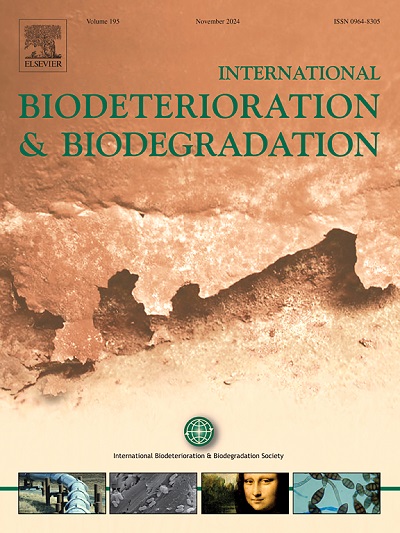Metatranscriptomic profiling reveals microbial succession and adaptation strategies during long-term lignocellulose degradation
IF 4.1
2区 环境科学与生态学
Q2 BIOTECHNOLOGY & APPLIED MICROBIOLOGY
International Biodeterioration & Biodegradation
Pub Date : 2025-05-07
DOI:10.1016/j.ibiod.2025.106110
引用次数: 0
Abstract
Lignocellulosic biomass is an abundant and renewable feedstock, promising for biofuel production and other industrial applications; however, it presents numerous challenges due to its complex structure. Alternatively, microbial systems naturally possess robust mechanisms capable of efficiently degrading this material. In this study, we investigated the functional and compositional changes of a microbial community in the early and late stages of adaptation to a lignocellulosic substrate using a metatranscriptomic approach. The results revealed a transition in the contribution of major phyla associated with degradation, with Bacteroidota decreasing from approximately 18 % to less than 1 % of the relative abundance of expressed transcripts, while Bacillota increased from approximately 3 % to more than 27 % in the late stage. In parallel, a proportional increase in CAZymes related to cellulose and hemicellulose breakdown was revealed in the late stage, suggesting greater cellulolytic and hemicellulolytic activity at later time points. Notably, a substantial fraction of transcripts identified as key lignocellulases (>30 %) were affiliated with the genus Paenibacillus (phylum Bacillota), highlighting its significant role in biomass degradation throughout the adaptation period. These findings highlight how prolonged exposure to lignocellulosic substrates selectively increases microbial taxa and enzymatic pathways critical for efficient biomass conversion. Such results are relevant for the development of biotechnological solutions such as enzymatic bioprospecting and industrial optimization of microbial lignocellulose processing, as well as for the development of strategies for the enrichment of high-performance degraders through targeted cultivation.

超转录组学分析揭示了长期木质纤维素降解过程中的微生物演替和适应策略
木质纤维素生物质是一种丰富的可再生原料,在生物燃料生产和其他工业应用方面前景广阔;然而,由于其复杂的结构,它提出了许多挑战。或者,微生物系统自然具有强大的机制,能够有效地降解这种材料。在这项研究中,我们使用亚转录组学方法研究了微生物群落在适应木质纤维素底物的早期和后期的功能和组成变化。结果显示,与降解相关的主要门的贡献发生了转变,拟杆菌门在表达转录物的相对丰度中从大约18%下降到不到1%,而杆菌门在后期从大约3%上升到27%以上。与此同时,与纤维素和半纤维素分解相关的酶在后期呈比例增加,表明在较晚的时间点纤维素分解和半纤维素分解活性较高。值得注意的是,被鉴定为关键木质纤维素酶的转录本中有很大一部分(30%)与芽孢杆菌属(芽孢杆菌门)有关,这突出了它在整个适应期生物量降解中的重要作用。这些发现强调了长期暴露于木质纤维素底物是如何选择性地增加微生物分类群和对有效生物质转化至关重要的酶途径的。这些结果与生物技术解决方案的发展有关,如酶生物勘探和微生物木质纤维素加工的工业优化,以及通过定向培养富集高性能降解物的策略的发展。
本文章由计算机程序翻译,如有差异,请以英文原文为准。
求助全文
约1分钟内获得全文
求助全文
来源期刊
CiteScore
9.60
自引率
10.40%
发文量
107
审稿时长
21 days
期刊介绍:
International Biodeterioration and Biodegradation publishes original research papers and reviews on the biological causes of deterioration or degradation.

 求助内容:
求助内容: 应助结果提醒方式:
应助结果提醒方式:


